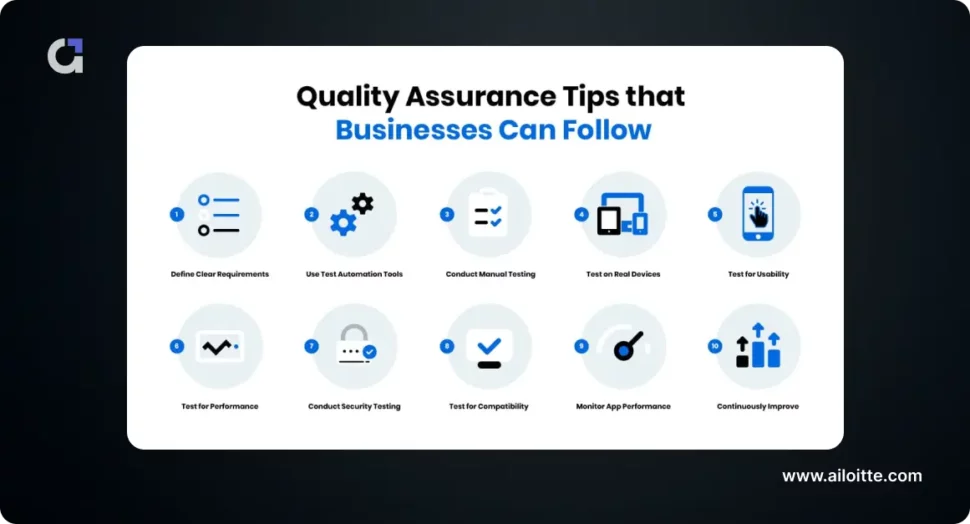In today’s competitive market, businesses leverage IT solutions to streamline operations, enhance sales, automate processes, and improve their reputation. However, with over 6.5 million apps available in various app stores, merely providing the intended functionality is an ineffective strategy. To stand out, businesses must deliver solutions that are both user-friendly and intuitive for their customers while also being technically robust and secure.
In other words, a successful IT solution should not only simplify and accelerate operations but also offer an outstanding user experience. Simultaneously, it must ensure data security and maintain technical integrity.
Quality is a critical factor for businesses to succeed, and many companies recognize its significance in delivering favorable outcomes. While some companies have already implemented quality assurance tools and techniques to improve their products and strategies, others may question why there is so much emphasis on this aspect.
In today’s saturated mobile application and smartphone market, users are increasingly selective and have numerous alternatives. Therefore, if users encounter a low-quality product, they are more likely to reject it.
This is where mobile app quality assurance plays a vital role. By ensuring that a mobile app meets the necessary quality control standards, businesses can increase their chances of success in this competitive market.
In this blog, we will examine the importance of quality assurance in mobile app development, how it differs from testing, the consequences that businesses may face due to improper quality assurance, and some tips that companies can follow. So let us get started.
Importance of Quality Assurance in Mobile App Development Process
Quality assurance is a crucial aspect of mobile app development that ensures the final product meets the required quality standards. Any security breaches can lead to severe consequences for the user and the developer.
Quality assurance helps to ensure that the app is bug-free and works seamlessly on different devices, operating systems, and networks. This is important because users expect apps to function reliably and efficiently. Any defects or errors can lead to negative user reviews, low ratings, and declining user engagement.
Also, by identifying and fixing usability issues, such as confusing navigation, slow load times, and poor design, app quality assurance ensures that the app is easy to use, provides a positive user experience, and reduces the need for expensive rework and delays, resulting in faster time-to-market and lower development costs.

Testing is not the same as Quality Assurance
Most businesses mistake software testing and quality assurance to be the same, but they are two distinct activities in the software development process. While they are related, they serve different purposes.
Testing involves checking software to find defects and errors that could affect its functionality and performance. This is usually done by a dedicated testing team or individual testers, who use various app testing strategies and techniques to uncover bugs and ensure that the application behaves as intended.
On the other hand, app quality assurance is a broader process encompassing all activities that contribute to ensuring that a software application meets the required quality standards. It involves identifying, evaluating, and controlling risks that could affect the quality of the software product. Quality assurance is not limited to testing but includes other activities such as requirements analysis, design, coding standards, documentation, and project management.
While testing is essential to quality assurance, it is different. Testing only focuses on finding defects and errors in the application. At the same time, quality assurance takes a more holistic approach to ensure that the application meets the required quality standards in all aspects of its development. It helps to prevent defects and errors from occurring in the first place, rather than just detecting them afterward. This can save time and money, as defects found later in the development process are often more expensive and time-consuming.
Also read: Difference in mobile and web app testing
Therefore, software testing and quality assurance are essential for delivering a high-quality app that is reliable, functional, and user-friendly.
Consequences of Not Following Proper QA During Mobile App Development
Poor Quality Assurance(QA) can have numerous consequences, affecting the app’s reputation, performance, and user satisfaction. We shall now explore the consequences of poor QA for your mobile app.
Negative User Reviews and Ratings
If users encounter bugs, crashes, or other issues, they will likely leave negative feedback on app stores, hurting the app’s reputation and reducing its downloads. Low ratings and negative reviews can make it challenging to attract new users and retain existing ones, as they may see the app as unreliable or of poor quality.
Increased Churn Rate
Poor QA can also lead to an increased churn rate, which refers to the rate at which users uninstall or stop using an app. If users experience issues with the app, they are more likely to uninstall it and switch to a competitor’s app that provides a better user experience. High churn rates can hurt an app’s growth and revenue potential, as retaining users and building a loyal user base can be challenging.
Loss of Revenue
If the app has bugs or crashes, users may not be able to complete transactions or use premium features, which can result in lost revenue opportunities. Additionally, if users uninstall the app due to poor performance, the app may miss out on future revenue potential from those users. This loss of revenue can be detrimental to an app’s success and viability, particularly for startups or small businesses that rely on the app as a source of income.
Damage to Brand Reputation
If users encounter issues with the app, they may associate them with the brand itself, even if a development or QA team caused them. Negative reviews and ratings can harm the brand’s image and make it challenging to build trust with new users. Damage to brand reputation can have long-lasting consequences and be challenging to repair.
Increased Development Costs
If issues are not caught early in the development process, they can be more complex and costly to fix later. The development team may need to spend additional time and resources fixing bugs, testing, and re-releasing the app, which can delay its release and increase the overall cost. Increased development costs can be problematic for startups or small businesses with limited resources and budgets.
Legal Issues
In some cases, poor QA can result in legal issues for an app. For example, if the app’s bugs or crashes result in data breaches or security issues, the app may be held liable for damages. Legal matters can be costly, time-consuming, and damaging to an app’s reputation and brand image.
QA should be an ongoing process throughout the development cycle and beyond to catch issues early and ensure that the app meets user expectations. By prioritizing QA, app development teams can avoid the consequences of poor quality and build successful, high-quality mobile apps.
Quality Assurance Tips that Businesses Can Follow
As mobile app usage continues to grow, ensuring the quality of mobile apps is becoming increasingly crucial for businesses and developers. To make sure that a mobile app is high-quality and meets user expectations, the following mobile app quality assurance checklist and strategies can be employed.
- Define Clear Requirements
- Use Test Automation Tools
- Conduct Manual Testing
- Test on Real Devices
- Test for Usability
- Test for Performance
- Conduct Security Testing
- Test for Compatibility
- Monitor App Performance
- Continuously Improve

1. Define Clear Requirements
One of the most critical steps in ensuring the quality of a mobile app is to define precise requirements. This means identifying what the app is intended to do, what features it should have, and what kind of user experience it should provide to meet their expectations and be bug-free.
2. Use Test Automation Tools
Test automation tools can be an asset when it comes to ensuring the quality of a mobile app. These tools can automate the testing process, thus saving time and improving accuracy. There are many test automation tools available that can be chosen as per the niche of the app.
3. Conduct Manual Testing
While test automation tools can be helpful, they should not be relied upon exclusively. Manual testing is still an essential part of the quality assurance process for mobile apps. The process involves having human testers use the app and provide feedback on its performance, usability, and overall quality control.
4. Test on Real Devices
When testing a mobile app, it must be tried on real devices rather than relying solely on simulators or emulators. Testing on real devices can help to identify issues that may not be apparent when testing on a simulator or emulator. Additionally, testing on real devices can ensure that the app performs well on various devices and operating systems.
5. Test for Usability
Usability is a crucial factor in the success of a mobile app. To ensure that an app is usable, it’s important to conduct usability testing. This involves having actual users test the app and provide feedback on its ease of use, intuitiveness, and overall user experience.
6. Test for Performance
Performance is another critical factor in the quality of a mobile app. Users expect apps to perform quickly and smoothly without lag or crashes. To test for performance, it’s essential to test the app under various conditions, such as low network connectivity or high user activity levels.
7. Conduct Security Testing
Security is a top concern for many users, so it is essential to ensure that a mobile app is secure. This involves conducting security testing to identify any vulnerabilities or weaknesses in the app’s security. Address any security issues before releasing the app to the public.
8. Test for Compatibility
Mobile apps need to be compatible with a wide range of devices and operating systems. To ensure compatibility, it’s essential to test the app on the various devices and operating systems it will be made live. This helps identify any issues that may arise due to differences in hardware or software.
9. Monitor App Performance
Once a mobile app is released to the public, it is essential to continue monitoring its performance. This helps identify issues arising after release, such as bugs or performance issues. Monitoring app performance can also help to identify areas for improvement or new features that users may be requesting.
10. Continuously Improve
Finally, it’s important to continuously improve the quality of a mobile app. This involves addressing user feedback, identifying areas for improvement, and releasing updates that address any issues or add new features. By continuously improving the app, you can ensure it remains high-quality and meets user expectations.

Ensuring the quality of a mobile app is critical for its success. By following the above quality assurance best practices and methodologies, you can help to ensure that your app meets user expectations.
How Ailoitte Handles Quality Assurance Issues in Mobile App Development
Ailoitte is a renowned app development company that provides a comprehensive range of services in mobile, web, and desktop application development, quality assurance, and testing. In case of any quality assurance issues that arise during mobile app development, our team of certified test engineers and test managers work independently or in collaboration with your development team to identify and resolve the issues.
Our app quality assurance testing services cover a broad spectrum, including functional and non-functional testing, manual and automated testing, and testing at various stages of software development. Our functional and non-functional testing approach involves both manual and automatic tests to ensure that the application functions appropriately concerning the requirements.
For instance, while working on a finance app, we noticed a drop in users clicking through to view more information about trading plans on a pop-up window that displays plans they can invest in. To ensure that users could easily access the full functionality of the app, we conducted an A/B test. After 30 days, the examination revealed that a variation in the existing application led to a projected 25% increase in the plan’s schedule usage. This successful outcome demonstrates the value of quality assurance in software development.
FAQs
No, Quality Assurance (QA) cannot prevent all bugs in an app. While the goal of QA is to minimize the number of bugs and ensure that the software meets the required standards and specifications, it is impossible to catch every possible issue during testing.
To prepare a Quality Assurance plan for an app, you should start by identifying the scope of the app, its intended audience, and any specific requirements or regulations that must be met. Next, you should define the testing strategy, including the types of tests that will be performed, the tools and resources that will be used, and the roles and responsibilities of the testing team. Finally, you should outline a timeline for the QA process, including milestones and deadlines for testing, bug fixes, and release dates.
The advantages of Quality Assurance include improving the overall quality of the software, reducing the number and severity of bugs, increasing customer satisfaction, minimizing the risk of product failures, and reducing costs by identifying & fixing issues early in the development process.


















.png)
.png)
.png)



Leave a Comment